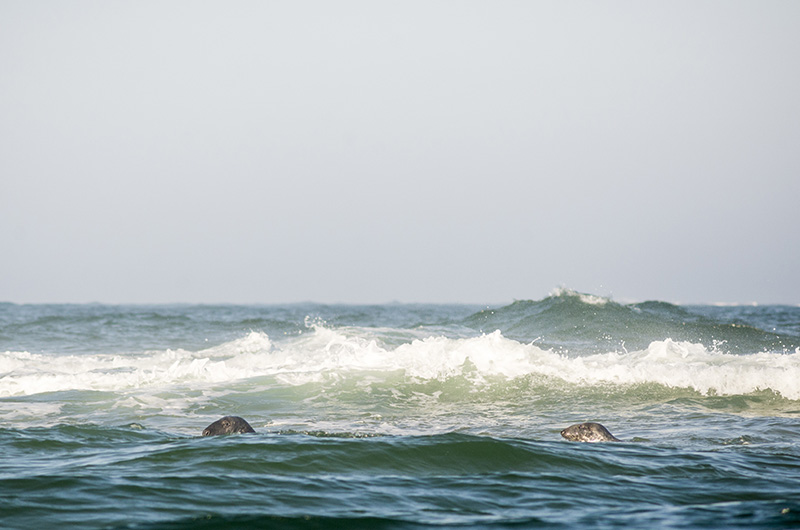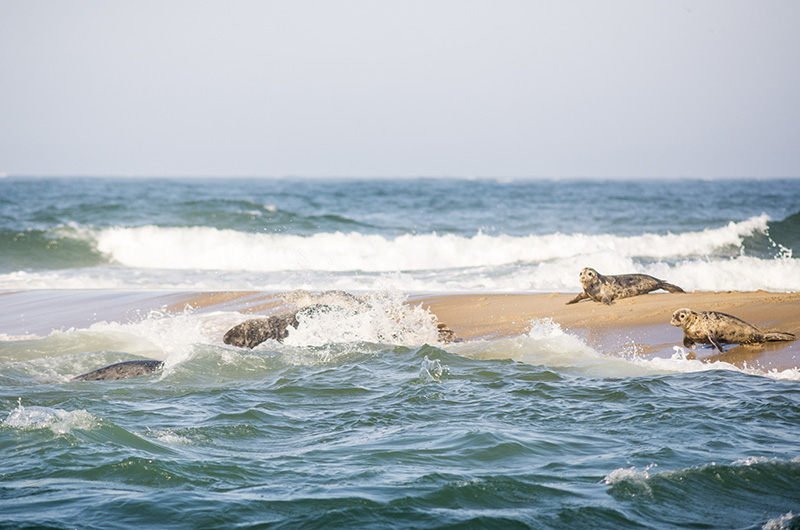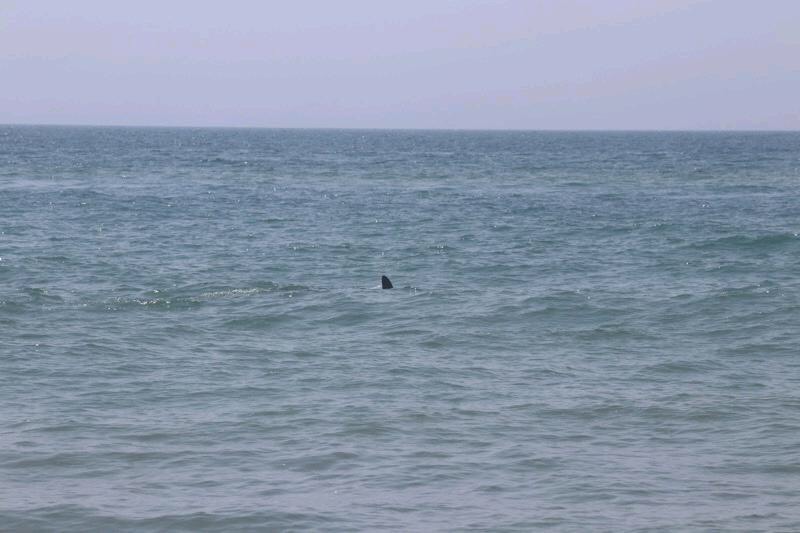In the aftermath of a rare shark sighting that temporarily closed South Beach in Edgartown on Tuesday, researchers are looking for answers as to what is drawing sharks to the Cape and Islands in large numbers in recent years.
The shark was spotted just 20 yards offshore near Norton Point. Amid a wave of concern over the beach closure at the height of the summer season, experts warn against irrational fear as they explore the scientific and historic basis for the increasing presence of sharks in local waters.
A leading reason, marine biologists believe, is that sharks are preying on a seal population that has been rising steadily over the last four decades due to federal efforts to protect what was once a dwindling population.
But for now there are even more basic questions to answer, such as the size and type of shark that was sighted.
Greg Skomal, the state’s leading shark expert and longtime Vineyard resident, was unable to confirm any details on the shark — which he was only able to examine in a photograph that presented nothing more than an exposed dorsal fin.
“It could be a number of shark species,” Mr. Skomal told the Gazette following the incident. “Local guys are catching a lot of brown sharks right now and there have been some reports of hammerheads in the area.”
He said shark sightings that close to Vineyard shores are rare, especially during peak season in late July and August when the majority of the highly-migratory species have already pushed further north towards the outer Cape.
“We don’t see many individuals staying around,” Mr. Skomal said. “In the early season they tend to slide by the south shore of the Vineyard and the outer part of Nantucket on their migration north. They tend to just be passing through.”
Mr. Skomal was set to speak about sharks at an event at the Whaling Church in Edgartown last night, long before the sighting occurred. He speculated that the already anticipated event would draw an even larger crowd this year.
In an interview last week, prior to the sighting, he spoke more broadly about the ongoing study of sharks and seals.
“There are certainly a number of factors driving the distribution of sharks,” he said. “One being sharks feed on seals and typically do so in areas of high seal activity.”
In recent years, seals have come onto the radar of many different organizations regarding their interaction with humans, sharks and other local fisheries. There are basically two opposing camps: one that wants to uphold species conservation and another that wants to adjust the federal act that protects the species.
A stock assessment report from the National Oceanic and Atmospheric Administration (NOAA), the organization that oversees all marine mammals including seals, found an estimated 28,000 to 40,000 seals in southeastern Massachusetts out of a larger population of 425,000 throughout the US and Canada. The population is large enough to be listed as not endangered, though still federally protected.
But this was not always the case.

Seals have been hunted along the Atlantic seaboard since pre-colonial days, with a large uptick after the first few waves of European settlement spread along the coast in the 18th century. Beginning in the late 19th century, Massachusetts and Maine put a bounty on seals, ranging from $1 to $5 per snout.
Kimberly Murray, leading seal-researcher for NOAA, said at the time seals were seen as competition for local fisheries. According to a report issued by NOAA, up to 135,498 seals were killed in the bounty hunt — enough to leave the population decimated by the turn of the 20th century.
In 1972, following decades of a dwindling seal population struggling to remain extant, the Marine Mammal Protection Act was enacted to set a broad net of protections for seals and other marine mammals such as dolphins and whales. The population began to rebound in the late 1990s. Now, 47 years since the act was passed, the waterfront is beginning to boil with speculation that the once-endangered species has reached, or perhaps even surpassed, a sustainable level.
Crocker Snow, a majority owner and part-time resident of the 250-acre Muskeget island off Nantucket, has studied and experienced the surge in population firsthand. “Gray seals. . . dominate the Island completely during their pupping season . . . between mid-December and mid-March,” he said.
According to Ms. Murray, the small island located eight miles east of Wasque is the largest pupping colony in the U.S.
Mr. Snow, who spoke at a Gazette Tuesday in the Newsroom event this year, said a census conducted by NOAA counted upwards of 10,000 gray seals hauled out this past winter, up from only a handful in the 1980s. He said the seals are damaging the environment, including dunes and freshwater ponds, and causing an imbalance in the local ecology.
Muskeget and Noman’s Land are both favorable for pupping because the waters surrounding the islands are shallow and the seals’ largest natural predator, sharks, prefer eight to 10-foot waters.

In the summer months, seals prefer not to spend as much time hauled out on islands like Muskeget, and can be found feeding throughout Nantucket and Vineyard Sounds. Many push close to Vineyard shores. According to NOAA, gray seals can eat up to four to six per cent of their body weight each day. A full-grown bull can weigh up to 880 pounds, meaning it could eat up to 50 pounds of fish, crustceans, squid and even birds per day.
“There are seals, night and day, on almost every wreck and shoal. It has become a common experience to have one grab a striper off the line, if you’re lucky enough to hook one at all,” said commercial fisherman Alex Friedman, who said he counted 13 seals off South Beach one late July afternoon.
“We are seeing more seals on the Island than we did 10 or 20 years ago,” said Chris Kennedy, stewardship manager for the Trustees of Reservations. Though he said he has no direct evidence, he added: “Intuitively with an increased seal population there has to be an increased shark presence.”
A handful of organizations are calling to amend the Marine Mammal Protection Act. One is the Seal Action Committee (SAC).
“The seal population has not only recovered. It has recovered to a point that has started to cause problems,” said founder Peter Howell. “It is impacting fisheries, public health and safety and causing an ecosystem imbalance.”
Though SAC only advocates for deterrence of seals from recreational spaces, some individuals are calling for culling or sterilization of the population.
“I’m in support of either culling or sterilization,” said Mr. Friedman. “We removed seals’ natural predators . . . It was human beings who altered the ecosystem that had predation and therefore a balance for seals. It’s our responsibility to manage the species for the benefit of a healthy ecosystem.”
But Ms. Murray does not believe the abundance of seals is necessarily a bane of the local ecosystem. Nor does she believe any measures to limit the seal population will be effective.
“To me it’s a sign that the Marine Mammal Protection Act is working,” she said. “The original intent was to recover the species, so in that sense it is a success story. Real efforts to reduce the population size here would be futile because they are just going to be replaced by seals migrating south from Canada . . . if there is more space.”
Mr. Skomal’s added his stance on sharks to an already complex equation.
“Single species fisheries management, where you regulate to maximize one single stock at a time, that is the traditional approach fisheries management has been using for 100 years,” he said. “It’s not a new concept, but marine ecosystem management, where you’re managing multiple populations to maintain an equilibrium instead of whacking individual populations down, is starting to take off.”
He concluded: “A healthy ecosystem has top predators and sharks are top predators. A lot of people complain about the presence of seals in these waters. The shark is a natural remedy. It removes seals in a balanced ecosystem . . . a natural predator consuming its natural prey. The only problem is that they are doing it in recreational areas.”








Comments (3)
Comments
Comment policy »